



Angela Washko is an artist, writer and facilitator devoted to creating new forums of discussions in spaces most hostile towards feminism. She is a Visiting Assistant Professor at Carnegie Mellon University. Since 2012, Washko has also been facilitating The Council on Gender Sensitivity and Behavioral Awareness in World of Warcraft, her most known project: it’s a series of actions taken within the virtual space of World of Warcraft (“WoW”), an online video game set in a fantasy universe in which people play as orcs, knights and wizards. Her research is focused on the social relations between the gamers, with great attention towards on how these relate with feminism and women, who are becoming more and more numerous between the players of this game. Washko investigates also how design elements of the game influence the relationships of the people who inhabit it; it’s a social study on a community expanding more and more widely, and acts within a limited set of rules designed by video game producers.
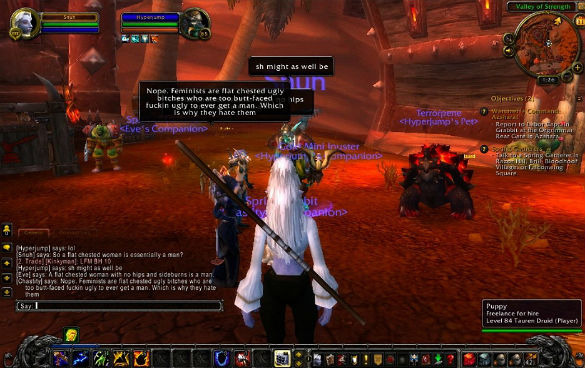
Filippo Lorenzin: I’ve read in some your previous interviews that you started playing WoW in 2006, so we can say you’re a veteran gamer. In the same interviews you pointed out many important elements linking to some of my own research. First of all, the fact you didn’t hesitate to make a parallel between IRL public spaces and online public spaces makes me think you’re part of a generation (as me) that doesn’t care of this division. You create situations and opportunities to let people discuss: it’s as if you meant online gaming as a social activity, rather than a set of rules designed by programmers in which people interact as NPCs (“Non-Player Characters”). What do you think?
Angela Washko: I wouldn’t say that I don’t make a distinction between online and offline space… rather, that these spaces are so integrated and much less separate than the outdated “it’s online/digital therefore it’s not real” model. Online gaming is a very general term and they each have a specific way of operating with contexts that have particular ways of allowing players to communicate to each other. Some of those games are designed to institute high degrees of collaboration in order to get to the most difficult content. World of Warcraft falls into this category. This coercive collaboration breeds a social/chat structure which makes the game as much of a social space as a play space.
My work in WoW is about analyzing the user’s social culture created within the otherwise fantasy oriented landscape and talking to players about the way that it’s developed. So of course there are thousands of things I could have focused on within WoW (and in The World of Warcraft Psychogeographical Association I focus more on exploring the landscape free from quest suggestion/utility and drift about exploring), but for The Council on Gender Sensitivity and Behavioral Awareness in World of Warcraft I was driven to work the way I did due to the treatment of women by the community within the space once players establish their self-identified gender behind the screen. At least on the servers I was playing on.
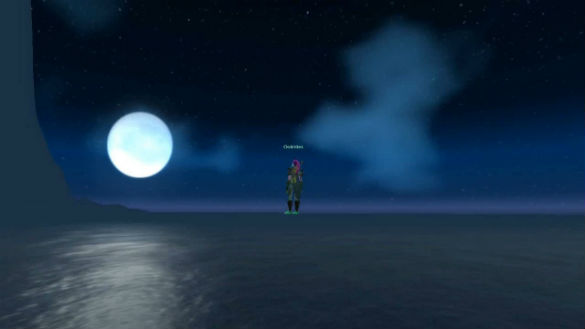
FL: Your use of WoW mechanics in order to raise questions about sexuality and identity makes me think of situationist approaches. As they wanted to create new urbanism refecting the grounded needs and identities of the people, and your actions seem to lead to the creation of a new gaming system, based on players/people who aware of the characteristics of the game and their results in the definition of their identities. Am I wrong?
AW: I guess in WoW I was wondering why the politics of everyday life outside the screen had to govern the rules of this otherwise epic and otherwise not-human-like landscape. I wondered why women were excluded or treated as though they were inherently unskilled (naturally/biologically non-gamers) and at the same time were rewarded for being willing to be abstractly sexualized in guild hierarchies and elsewhere. After being asked to “get back in the kitchen and make [insert player name here] a sandwich” enough times, I stopped playing for a bit. And then I returned, determined to figure out why this was an ubiquitous approach to talking to women in the game space. So I wanted it to be in a place where we could openly discuss and potentially become more considerate about communal language to the point that it could become a much more inclusive space for everyone, and maybe a more diverse social space than we all curate for ourselves in our everyday (physical space) life. Why did our identities outside the screen still have to govern how we are treated as orcs and trolls and whatnot? This game still holds onto a lot of the qualities of the avatar-hidden web 1.0 persona…
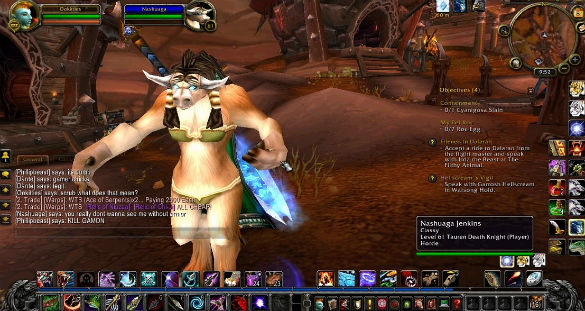
FL: Debord wrote that “the construction of situations begins on the other side of the modern collapse of the idea of the theatre. It is easy to see to what extent the very principle of the theatre – non-intervention – is attached to the alienation of the old world. Inversely, we see how the most valid of revolutionary cultural explorations have sought to break the spectator’s psychological identification with the hero, so as to incite this spectator into activity by provoking his capacities to revolutionize his own life. The situation is thus made to be lived by its constructors.”.
As you can see, it looks like he’s describing your work and I’m really curious to know your opinion.
AW: Well, I have thought about this work (and the psychogeographical work that came slightly later) as definitely linked to Debord and Situationism. I think I became tired of just being able to show the injustices women face everyday. Just prior to the WoW work, I was making videos from replaying single player RPGs from 1992-2003ish showing only women’s storylines and the ways women were represented. I think the work shocked the gallery audiences who saw it because they weren’t gamers and instead of making them think about why the ways in which “women are supposed to act” are embedded in all of our cultural artifacts – it made audiences ask me why anyone would play video games? This frustrated me because I hated the 90s stereotypes that existed about gamers being delinquent and lazy and so I wanted to have conversations in game spaces themselves among the communities that I was involved in rather than just taking from games and then putting them into an art context to be exoticized by art audiences. This is changing a lot as more people identify as gamers and more academics realize the massive amount of people that play games and the cultural importance of games themselves. But I wanted to be able to create a space for discussion with the playerbase itself directly and make that the work rather than making some kind of insightful commentary – to give voice to the community itself to let it speak for itself (regardless of my point of view on the matters discussed) and at the same time try to make sense of how it ended up the way that it did.
FL: The players are being involved in discussions about sexuality and identity. Could you tell your art and cultural references? I can see a lot of ’60s and ’70s approaches…
AW: Oh yes – I mean artists like Valie Export, Adrian Piper, Lynn Hershman, Sophie Calle and the Guerrilla Girls of course, in terms of performance and visibility of women and feminism/feminist activism but in terms of public/media intervention and social practice I think of people like Paper Tiger TV, The Yes Men, The Center for Post Natural History, The Institute for Applied Autonomy, Dara Greenwald, Ant Farm, Kristoffer Orum and Anders Bojen.
I also feel very indebted to remix/appropriation artists like Craig Baldwin who have reclaimed what can be used and how we can rethink existing pop cultural material as sites of intervention for artwork. I also feel like I’m even more influenced by diaristic women writers– particularly Phoebe Gloeckner, Kathleen Blee (sociologist), Elfriede Jelinek, Chris Kraus, Kathy Acker…
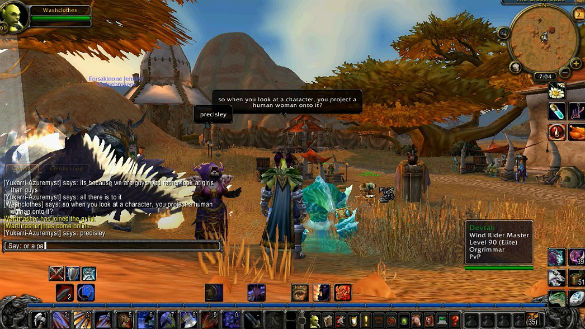
FL: Though question: do you think artists have (or “must have”) a social role? And if they take a stand, what should be their goals?
AW: I think for me interesting artists have a social role! I don’t think that all artists have to make socially engaged work or have to have some kind of service responsibility. I think what was appealing to me about pursuing art as a context for the things I aspire to do is that it is so broad! I mean you have so many “art worlds”, this is a really broad question! So I would say no, but I think artists are in a unique position to have so much flexibility in what you’re permitted to do in your work. In a sociology context, my work would require so much paperwork it would be impossible to get every player I talk to in WoW for my research to sign the necessary papers outside of the game space! So art affords me the flexibility, spontaneity and responsiveness to context to experiment, and really get in there in a way that other fields don’t. So I have found for someone interested in looking at why women are treated the way that they are in fields that are ephemeral and difficult to document, and wanting to have direct discussions about it…art seems to be the field for me to do it in.
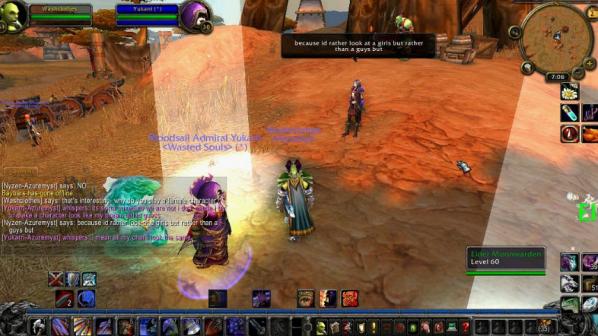
FL: What did you learn from your projects?
AW: Things that I learned which I think will be beneficial for me in the future:
– Be responsible and respectful to everyone you work with.
– Be flexible and responsive. Recalibrate your expectations and be prepared to be wrong about every assumption you’ve already made.
– Think about power. Remember that by being able to capitalize on what you collect, you are in a position of power – make efforts to put yourself in positions of vulnerability. Acknowledge whether or not what you are doing is exploitative. Make everything you do available to all participants who are interested.
– Be clear about what you are doing with the people involved. Be upfront with your participants.
FL: As you previously stated, feminism is a really important element of your research. Did you notice any change between 2010 and now? I’m especially referring to how feminists are portrayed by society, the opportunities in which you can debate and share ideas with somekind of new wave of young artists and critical thinkers who are also deeply involved in these discussions.
AW: When I first started the project, “feminism” was the worst possible word you could say in WoW. Everyone went crazy – feminists were widely described as man-hating whores, flat-chested ugly bitches, women with hairy armpits and worse. But I’ve definitely noticed over time with more mainstream visibility and more writing and a younger generation of artists and celebrities identifying proudly as feminists…the discussions about feminism have become much more complex in WoW and there are many more perspectives and a lot more people self-identifying that way in the space.
Outside of WoW, it seems like more and more women are identifying as feminists and a lot of young writers are really making space for feminism in mainstream media. However, I think it’s been quite polarizing and alienating as well. More and more Men’s Rights Activist groups and nearly militarized manosphere communities are popping up. So with the growth of feminism we also have the growth and visibility of self-identified counter-feminist movements. I think the fact that feminism is a part of mainstream media vocabulary in a way that is a bit more dimensional is definitely positive. The ideas of what a feminist and what a woman can be/do are shifting and evolving and that’s exciting to see.
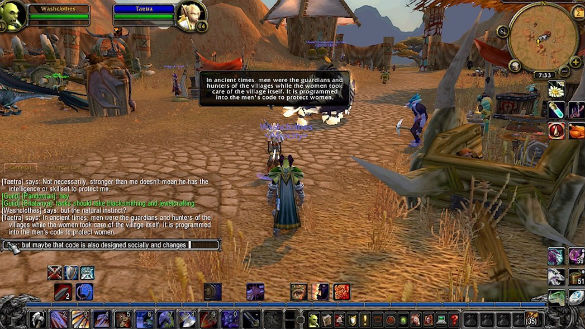
FL: Products like WoW are designed for a masculine audience but looks like it’s not so evident for most of them. With your actions you push other players to discover this aspect, so I wonder if you would define your research as critical art, and or an art that helps others to see the reality behind what the system teaches them).
AW: I would definitely call my work critical art in regard to what you’re proposing! I think in all of my work I am looking at systems and trying to reveal the way they work, using an approach that is accessible to wider audiences than the systems typically reach. I like to approach cultural artifacts by exploring and then dissecting them and then translating/excavating those findings from the site and sharing them as widely as I can.
“It emerged from the forest behind the Collins house one evening in May and zeroed in on Sandy, the family’s 50-pound Labrador mix. As two of Collins’ children watched from the doorway, the cougar chased Sandy around the house and cornered her by the back deck.Clamping its jaws around the dog’s neck, the cougar dragged Sandy 50 yards into the woods. There it gnawed on her head and shoulder, buried the rest for later, and stretched out for a long nap.” [1]
In an inspired moment, we decide to drive a semi-trailer truck up a steep hill. This sort of interaction comes naturally in “Grand Theft Auto V” (GTA V) and it perhaps makes up for all the early driving games where leaving the road resulted in losing the race or the destruction of the vehicle. Leaving the road, leaving the story and leaving the rational is encouraged in GTA V. The Grand Theft Auto series of games are all loosely based on American cities: Liberty City on New York City, Los Santos on Los Angeles, San Fierro on San Francisco, Las Venturas on Las Vegas and Vice City on Miami. In a truly American dream, nearly all space in these cities is traversable by automobile. Running over more than a few pedestrians, or a single police officer, brings on a police chase, but driving over the line and into the wild is encouraged. It is necessary to complete a few of the scripted, trite, missions in order to acquire cash or unlock characters, but the game seems to invite and reward more creative explorations of space.
We have a large truck and intend to drive it up a very steep hill. We flip the radio station from the station that had been playing when we hijacked the truck to another station. The trucker we just flung to the ground has become an angry, red dot on our mini-map. “Still D.R.E.” by Dr. Dre is now on the radio as we cross the sidewalk and begin our ascent. We need to avoid the trucker, still chasing his truck as we pull out from our lane and position the semi at the base of the hill. Most drivers run from their vehicles when carjacked but others chase after our character and pull him out of the vehicle for a physical confrontation. Some truck drivers and others in the rural areas outside the GTA V city of Los Santos are armed.
The truck moves slowly up the incline, over the grass, as we avoid trees growing on the side of the hill. The Xbox game controller vibrates in relation to the terrain—haptic feedback letting us know we have left the road. We only make it halfway up the hill before gravity is pulling us back down. We attempt to swerve back and forth to get some traction but the truck reacts to being sideways on an incline in the same way it might outside the game space, it topples over sideways and slowly slides down the hill.
With a press of the Y button, we exit the vehicle and jump away without harm. Vehicles in GTA V cannot be righted so the truck is now useless and our semi-trailer truck ascent has ended all too quickly. We decide to attach a sticky explosive to the side of the truck and move further up the hill so we can detonate it remotely. In a moment only possible in a game space, perhaps only in this particular game space, we ignite the explosive and, as we watch the flaming wreck of the truck slide down across the sidewalk and into traffic, pedestrians fleeing in all directions, we are attacked and immediately killed by a cougar, whose approaching mini-map red dot we had failed to notice.
Cougars make the less developed areas of GTA V more dangerous to explore on foot. While it is possible to get mugged in the city [2], it seems much more likely to encounter a cougar attack outside the city than a criminal attack inside the city. The cougars in GTA V do not limit their attacks to playable characters: “I saw a cougar killing another person. I walked up to it, but then I changed my mind and ran off to the other direction. Heard a scream, looked at my left, and saw some poor smug being attacked and mauled.” [3]
This video shows a cougar running through the streets of a rural town, taking down pedestrians. [4]
“Three years have passed since Wes Collins moved his family into their house in the woods. Until the cougar attack in May, they enjoyed the parade of wildlife from their back door. Now the four children, ages 8 to 14, are not allowed to play alone outside. Collins bought a can of pepper spray, and he cleared trails out back “to make our presence known,” he said. Collins said he likes wildlife, but he values the safety of his children more. He’d like to see Washington rescind its new ban on hunting cougars with hounds. `You either control the population of cougars or start killing humans,’ Collins said. `There’s not enough room for both of us to survive.'” [5]
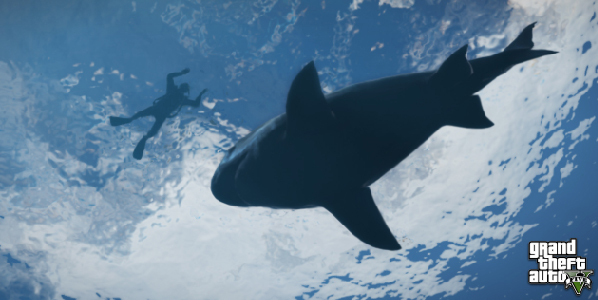
Jessie Arbogast was attacked by a 7-foot, 250-pound bull shark on July 6, 2001 and lost his arm and enough blood that he was left with anoxic brain injury. The dramatic rescue, with Arbogast’s uncle attacking the shark, dragging it to shore and retrieving Arbogast’s severed arm, set off months of shark-related coverage in the twenty-four-hour news cycle. Later and far away, in the Bahamas, an american tourist was attacked by another shark. A few weeks later, near the site of the attack on Arbogast, a surfer was bitten by yet another shark. Each event fed into the shark-focused coverage. Time magazine’s cover from June 30, 2001 proclaimed the summer of 2001 as the “Season of the Shark”. The cover featured a close up of shark’s jaws seen simultaneously from above and below the water. Two additional fatal shark attacks and constantly-repeated helicopter footage of shark swarms off the coast of Florida kept the focus on the dangers lurking in the water, until the morning of September 11, 2001, when this imagined danger became a less exciting story.
The attack of Jessie Arbogast is often cited as the beginning of the “Summer of the Shark.” However, six days earlier, in the London’s Daily Mail, Christopher Hudson presaged the media circus of Summer 2001 in a book review titled “Summer of the Shark.” [6] The review focused on two books about “a series of fatal shark attacks in a cluster of Eastern seaboard towns south of New York, complete with panic-stricken holidaymakers, attempts to hush up the danger, bill-posted rewards, and scientists joining the hunt to track down the killer.” The Jersey Shore shark attacks of 1916 were the basis of Peter Benchley’s novel “Jaws” and the subsequent, first, blockbuster film of the same name in 1975. Unlike the summer of 2001, the Jersey Shore attacks were confined to a small area and a period of two weeks. Prior to this, it was thought that sharks did not attack humans or even come close to swimmers. This was changed on July 12, 1916, when, after two attacks along the Atlantic coast, an approximately eight-foot long shark swam up Matawan Creek. There, it killed eleven-year-old Lester Stillwell and injured one of the men attempting to rescue Stillwell’s body, resulting in his death from blood loss. Thirty minutes later and a half-mile away, fourteen-year-old Joseph Dunn was pulled from a swimming ladder as he attempted to exit the water. He was rescued by friends and survived. [7]
We are riding a stolen jet ski out into the open ocean. The waves beneath us are beautifully rendered but seem separate from the space, as if by a sheet of glass. Although the jet ski reacts to the waves and we can even jump over them, the illusion is not completely convincing. We have not read anything about GTA V yet and we do not know what to expect as we head out from the city to see at what point the world ends. We vaguely hope the well-rendered materials will fade out to reveal bright green polygons, the triangular structures familiar to those lucky enough to have played Atari’s “Battlezone” (1980) or “Star Wars” (1983) on original, and intensely beautiful, vector monitors. We remember this fade from reality to polygons, however, as a cinematic device from the movie “The Thirteenth Floor” (1999) and it is unlikely to appear in a game like GTA V. If the Grand Theft Auto series has progressed in any way, it is in the visual details constructing a convincing reality that makes up the game space and a move towards, if not realism, then a seamless and convincing virtual world.
As we move outward over the rolling waves, we can not expect them to disappear, leaving the mathematical structure of the GTA V world. We must, however, expect our outward vector to end. All game spaces, even a space as open as that of GTA V, must have an endpoint. While some games generate terrain as the player moves forward, they must still have some sort of end, if only a limit based on how extensively code can describe a world. As noted by Markus “notch” Persson, the developer of “Minecraft” (2009):
“First of all, let me clarify some things about the ‘infinite’ maps: They’re not infinite, but there’s no hard limit either. It’ll just get buggier and buggier the further out you are. Terrain is generated, saved and loaded, and (kind of) rendered in chunks of 16*16*128 blocks. These chunks have an offset value that is a 32 bit integer roughly in the range negative two billion to positive two billion. If you go outside that range (about 25% of the distance from where you are now to the sun), loading and saving chunks will start overwriting old chunks. At a 16/th of that distance, things that use integers for block positions, such as using items and pathfinding, will start overflowing and acting weird…We’re probably not going to fix these bugs until it becomes common for players to experience them while playing legitimately. My gut feeling is that nobody ever has so far, and nobody will. Walking that far will take a very long time. Besides, the bugs add mystery and charisma to the Far Lands.” [8]
We know we have reached of the GTA V world, not because we hit an invisible wall, as in previous GTA games, but because our stolen jet ski cuts out and begins to sink. The open ocean is no longer a space that provides waves for jumping. The default camera view in GTA V is third-person, meaning our camera floats above and behind the character. Ours now looks small, wet and very far from the beaches of Los Santos, completely isolated. We have not yet noticed the red threat dot on our mini-map). We decide to begin swimming back, fairly confident that our character can swim for an unlimited amount of time, like previous versions of GTA. It looks to be a long, boring slog back to shore when we finally notice the red dot, close by and headed for our character. We turn in a circle, sweeping the camera around the horizon, and and see only open ocean. Similar to “Grand Theft Auto: San Andreas” (2004), characters in GTA V can swim under the water, opening an engaging but dangerous space for game activity. This world is murky, visibility is limited to a few hundred feet, and air runs out quickly. We dive under but do not immediately notice the shark. Still, we suspect the dot presents a serious danger. We begin swimming quickly but the red dot is getting closer. We swivel the camera in front of the character, trying to see the danger while also acting as cinematographer. The shark passes behind our actor and dives down. It is too late for swimming. The angle switches so that we are watching the character from above. The shark erupts from beneath him. Gaping jaws grab his torso and the shark shakes from side to side. He screams and blood pours out as our screen fades to the gray monochrome that GTA V employs to indicate that our virtual life has ended.
There remains some question about whether sharks appeared in Rockstar Games’ previous “Grand Theft Auto: Vice City” (2002), in which swimming was impossible. There are videos [9] that show sharks spotted via sniper rifle from a boat in the waters around Vice City. People also claim to have been attacked by sharks in “Grand Theft Auto: San Andreas”. They describe their character as having been bitten or stabbed to death while swimming. Others dismiss this as a myth, chalking up the deaths to players letting their oxygen level deplete to the point of death. Any video of sharks in previous games could be due to user modification of PC versions of the game. The appearance of unconfirmed urban legends and possible easter eggs are not new to video games [10] but the existence of controversy over whether sharks exist in a medium in which video screen capture and game edits are possible is a testament to the immersive and mutable reality of the GTA universe. [11]
Similar to the shark in the film Jaws, and unlike sharks outside media space, the sharks in GTA V can appear anywhere in the ocean and will always attack swimmers. There is no doubt about their existence in GTA V as Rockstar Games released a Jaws-like screenshot (above) when promoting the game. Their placement and the way they function as artificial life only in relation to the player underscores the cinematic basis of this space. A realistic artificial life algorithm would have the sharks looking for food and likely ignoring any humans in the water. Instead, shark attack is inevitable at the end of the world and the attack becomes a scene in which a player, unlike a viewer, has some agency. While we were unarmed and surprised, sharks can be killed with a knife. The attack takes place as an interactive event somewhere between a static cutscene and the open world of the majority of the game. Other wildlife, like the deer, appear more randomly in the game landscape and run from the player, or attack quickly and without cinematic build up, like the mountain lions which prowl the hills around Los Santos.
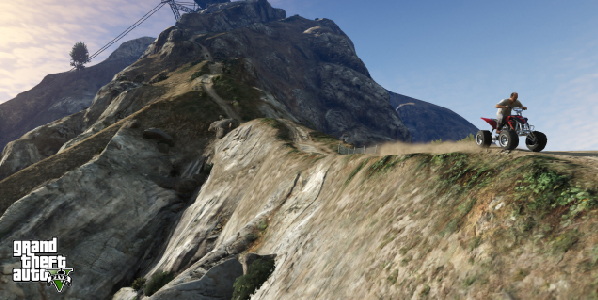
While the previous “Grand Theft Auto: San Andreas” had a large, rural space, the vehicles in the game were much more sensitive to vertical drops. In GTA V it is possible to drive a truck from a large cliff, crash, roll, return to all four wheels and continue. It reminds us of our early game experience with Hitmaker’s “Crazy Taxi” (1999), in which it was possible to drive the taxi cab under water, across hills and through train tunnels, with a screaming passenger in the back. GTA V’s cars will not drive underwater and when we are not careful, we end up sitting underwater, our experience of speed at an ignoble end. The drive for speed combined with the joy of hills and mountains, and experiencing those vertical spaces on ATVs, motorcycles, trucks, standard cars, luxury convertibles and even bicycles is incredibly compelling. As Paul Virilio writes of the Amerian 1960s lust, “To succeed is to reach the power of greater speed, to have the impression of escaping the unanimity of civic training.” [12]
Bounding over the hills in a more appropriate truck, one with large wheels and (we imagine) huge virtual shock absorbers, we delight in the incredibly large and ever changing vertical space. In addition to cougars, the rural spaces have deer and, occasionally, herds of deer. When we find a herd, high on the hilltop, they bolt and we follow them, not running them down, but not avoiding that possibility. We are moving quickly over the space, surrounded by a herd of animals, completely satisfied to move forward through the space. The experience is not a simulation of any possible natural world but instead reminds us again of cinema. In a scene from “Jurassic Park” (1993), combining blue screen, three dimensional animation and live action, three characters discovered a herd of dinosaurs, flocking as they sprint over the terrain. The dinosaurs turned towards the camera and the characters also began running, surrounded and trying to avoid being trampled. A Tyrannosaurus rex erupts from a copse of trees and takes down a smaller dinosaur. In GTA V we are both the possible danger and the characters moving with the herd, driving quickly across the landscape, a tight grip on the vibrating controller. As Soraya Murray describes her experience in “Grand Theft Auto: San Andreas”, “…though the bobbling image and rumbling controller in no way replicates the ‘actual’ feeling…the visual language effectively conveys the exhilarating rush in largely cinematic terms.”[13]
Each time we find a vehicle suited for off-road driving, we worry that it will eventually wreck completely. GTA vehicles show aesthetic damage when they collide with objects, people or animals and further collision results in the loss of doors, the car hood and tires. Wheels will eventually bend inward and outward, slowing the car. Finally, a car will catch fire and explode after too many falls or collisions. The spaces we seek out are fairly far from the roads, and the police, and these spaces do not present many vehicles to carjack once our primary vehicle explodes. Losing our truck could result in the death of our character or, much worse, require a hasty exit and a long walk back to a road where a new car can be found.[14] Nothing feels more alien to GTA V than hiking through the woods. The slow speed of trudging back to developed areas (or running, requiring constant button mashing and staying within the characters maximum endurance) is coupled with the danger of cougars, or simply falling off a cliff. While a vehicle can survive a ridiculous drop that does not match physics in the outside world, a character cannot.
There are good and bad deaths to be found in the GTA V game space. While there is no way to lose at GTA V, watching our character stumble over a cliff and bounce down a ravine feels closest to a loss. Driving into an unexpected and high speed collision with an object that cannot be destroyed by the car, and the subsequent ejection of the character, who takes flight for a short while before himself colliding with an immovable object, feels much more like victory. From the slow dread of our jet ski going under the water, and the sinking recognition that we are about to relive a movie scene, to an instant death by cougar, to leaving the vehicle via the windshield in a scene resembling a seatbelt safety video, GTA V, and the entire Grand Theft Auto series, relies on slapstick humor but more so on an intense desire for the active yet vicarious violence possible at the repeated end of the character’s life. In a doubling of the condition Steven Shaviro, referring to the attraction of death and dismemberment in horror cinema, calls “vertiginously passive fascination,” we connect with the character and in GTA V we desire and can attain death, over and over again. We seek the moment at which the game takes over and time slows down and we, and our character, meet an incredibly violent end. We are seduced by the promise of the destruction of the vehicle we were driving, our own virtual carnage, a spectacular end. “I’m taken on a wild ride through a series of thrills and shocks, pulled repeatedly to the brink of an unbearable and impossible consummation.”[15]
The experience Shaviro describes above, based on watching George Romero’s “Living Dead” trilogy, moves to a strange space between directing and suffering, indulging in and being removed from the violent physics of GTA V. Shaviro discusses the use of “special effects” in horror as “grotesque visual effects and…affective and physiological effects on the viewer.” Our character’s head smashes into the side of a boulder and there is instantly blood. The algorithms driving the game have already calculated this impact and that the character will not survive. We lose control and watch passively. This changes the camera mode to slow motion, presumably because the game developers, borrowing from horror cinema, know we want to prolong this moment. The character’s neck snaps and the body, still in motion, crumples before it smashes into the cliff face. Previously we were connected to the character, he was driving the car as we were driving the car, together. As his neck snaps, our connection is broken and he becomes a ragdoll. Ragdoll physics, a phrase that describes exactly what it is, take over and what was our character, and is now an abject body in the scene we constructed, spins wildly across the game space. The scene is not scripted, what transpires is based on what objects exist in the vector the ragdoll character moves through. Any unmoving object impacts this body and it flails in a new direction. Any moveable object skitters away until finally the body comes to a rest. Rockstar Games has selected the perfect phrase for this end and it has remained consistent across the GTA series. A word appears across the now completely gray monochrome screen in burgandy: WASTED.
_
This review was written with substantial input from Channel TWo collaborator Oskar Westbridge.
“Does Lara Croft Wear Fake Polygons?” that was the question Anne-Marie Schleiner (http://www.opensorcery.net) asked in a gender analysis essay of the popular videogame Tomb Raider published year 2000 in the Switch magazine.
The videogame Tomb Raider was released by Core Design in 1996 and the heroine a British archaeologist named Lara Croft did not only have big guns but also big breasts. In a couple of years she became a well known character not only in the games world but also for the general public when she entered the silvercreen, played by Angelina Jolie. You could say that Lara Croft is the Mona Lisa of the game world, beautiful, mysterious and well known for a large audience outside the games world.

In her essay Anne-Marie Schleiner mentions the famous Nuderaider patch, a game add-on that strips Lara Croft’s clothing so you could play her naked.
The artist Robert Nideffer’s Nuderaider patch made in 1999 consisted of three-parts:
1) an appropriated website where he repurposed the existing commercial site
2) a spoofed mail-server that re-routed messages submit to Lara Croft fan club website to the Director of development at Eidos UK as if it were coming from the Director of Marketing in the US branch
3) a patched version of the Nude Raider patch, which placed police blotter style bar codes across Lara’s private parts (and gave her a goatee as a Duchampian homage), thwarting the game player’s expectation of seeing her polygonal private parts.
“This shows the male dominancy within the game world by having a female lead appearing like a super model. By presenting her naked, it makes the game seem satirical just pushing the creators’ ideas a little further.” Nideffer [2]
In 1919 the artist Marcel Duchamp used a cheap postcard-sized reproduction of Leonardo da Vincis famous painting Mona Lisa on which he drew a moustache and a goatee, in the same way Nideffer later did with Lara Croft. Duchamp called his work L.H.O.O.Q a titled that pronounced in French should be “Elle a chaud au cul”, which translated to English means “She has a hot ass”.
Eidos sent cease and desist letters to the owners of nuderaider.com who were hosting the Nude Raider patch, enforcing their copyright of Tomb Raider.[3]
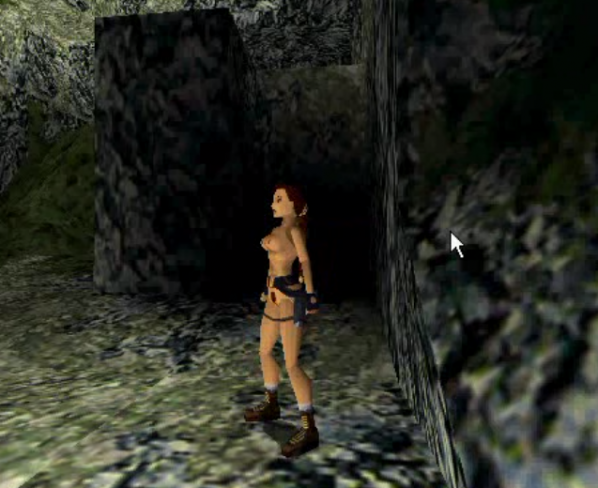
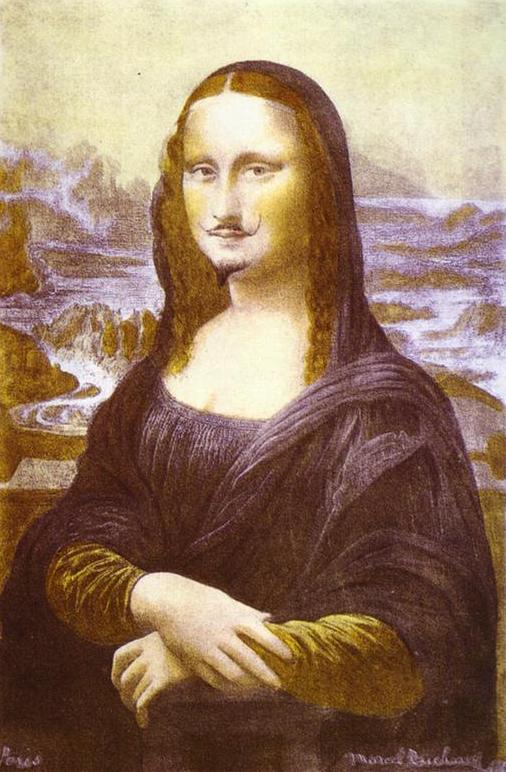
In the machinima “She Puppet” from 2001, the American artist Peggy Aswesh also investigates the gender and cultural identities of Lara Croft by mixing scenes from the Tomb Raider game. Aswesh describes Croft as a virtual girl-doll of the late 20th century, perhaps boy-doll would be a better description since most of the player of the early Tomb Raider games were men or boys. In her essay Schleiner makes the observation that Lara Croft is a “well-trained techno-puppet created by and for the male gaze.” It’s obvious that the videogame Tomb Raider has played a major role in stirring up emotions with its out of date and suspect attitude towards women. But Lara Croft has not only been a subject for critically engaged, artistic gender discussions.
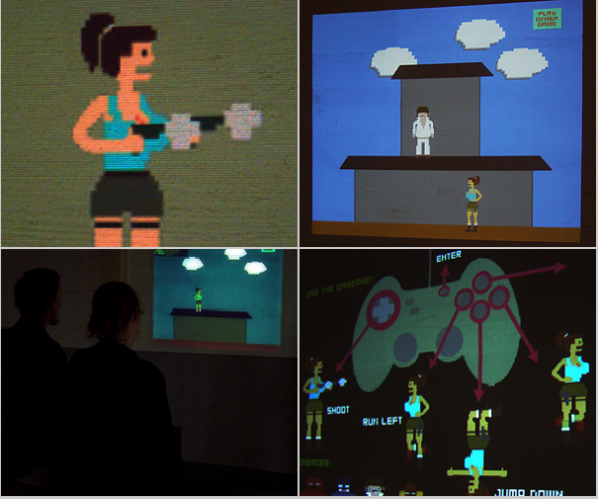
The artists Marieke Verbiesen has created the game Tombraider 0.1 in which she flattened the 3D game into a 2D-world and borrowed aesthetic from the early game consoles. In the new game you could also find references to classic computer gaming experiences such as the stuck “loading” screen, bad language translations and space-invader attacks. It is not unusually that artist create copies of videogames, with 3D hyperrealism graphic, in a retro old-fashioned style.
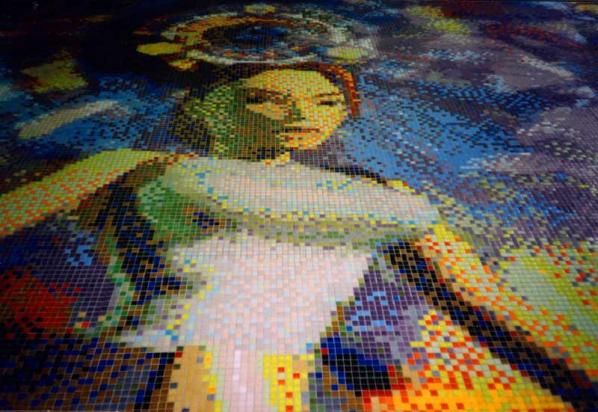
Another way to do this is to use pixel-graphic. That is exactly what Arno Coenen, Rob Coenen and, Rene Bosma did when they re-created he 3D game character into a 2D experience with a touch of pixel-feeling. The project Output: 62.500 materialized pixels, used 62.500 pieces to create a floor mosaic measuring 5,25 x 5,25 meters of the videogame icon Lara Croft. The mosaic has been exhibited at different places in Amsterdam and Kiasma at the Alien Intelligence exhibition in 2000.
So fake polygons or not, it looks like Lara Croft has not only made an impression in the history of videogames but also in the history of art.
Tombraider 0.1 – Single-player game installation based on the famous 3d game Tombraider, starring the female fightingmachine Lara Croft. http://www.marieke.nu/tombraider01/eng/
MUTATION.FEM. Anne-Marie Schleiner “An Underworld Game Patch Router to Female Monsters, Frag Queens and Bobs whose first name is Betty” http://www.opensorcery.net/mutation/